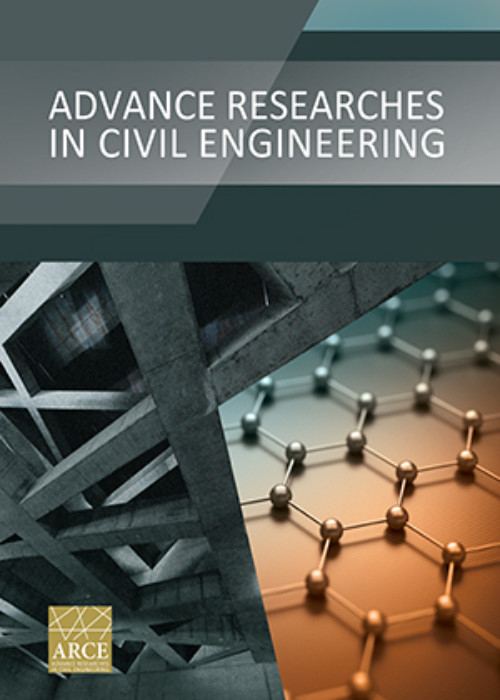فهرست مطالب

Advance Researches in Civil Engineering
Volume:4 Issue: 1, Winter 2022
- تاریخ انتشار: 1401/04/01
- تعداد عناوین: 4
-
Pages 1-14There are still today discussions about what formula shall be used to calculate head loss in water pipelines. Especially in academic circles, the Darcy-Weisbach (DW) equation is highly recommended, with a series of articles and scientific evidence on the subject. In the context of water supply companies, the Hazen-Williams (HW) equation gains a lot of strength, possibly even because, within the speed ranges that the systems operate, it can provide acceptable results. Thus, the present research provides a series of curves to adjust the HW roughness coefficients C, in order to make the obtained head loss results to be very similar to those derived from the DW equation. For the diameters of 50, 75, 100, 150, and 200 mm, spreadsheets were prepared, which indicated which value of C was generated for each flow rate, whose variation ranged from 0.05 to 287.00 L/s. It was verified in the spreadsheets, for each same value of C, which were the combinations of flow and diameter that produced it, and the same procedure was repeated for all C. Thus, each curve of C could be plotted. In order to assess the accuracy of the fit curves, points generated by the combination of flow and diameter outside the Hazen-Williams region of application were taken. Such points were plotted in the curves to obtain the adjusted C. This procedure made the results of HW much closer to those of DW, which when such a comparison was made using the values of C from the literature.Keywords: Head loss equation, Hazen-Williams, Darcy-Weisbach, Fitting curves, Water pipelines
-
Pages 15-33In the seismic analysis of structures, estimation of amount of damages to the elements is of great importance. In the quantitative method of estimating damages, it is possible to assess damages to the storey and the total structure by introducing damage indices. The results of studies show that damage indices could be used as a suitable basis in assessing the function of structure against back and forth forces of earthquake excitations. These indices are calculated based on functions of deformation, and dissipated energy of elements in frames. In this study, the steel moment-resisting frames with 4, 7, 10, 15, 20, and 25-story and 3 and 5 bays are designed and then, they are modeled in OpenSees software in order to investigate the performance of steel moment-resisting frames under seismic excitations by using damage index. In the following, nonlinear dynamic time history analysis is conducted and the damages of aforementioned frames are calculated quantitatively and the results showed that the behavior of high-rise, mid-rise, and low-rise frames were affected based on their vibration periods and dependent to the nature of the studied earthquakes.Keywords: quantitative method, Damage index, deformation, Dissipated energy, Nonlinear Dynamic Time History Analysis
-
Pages 34-53In evaluating the degree of structural damages after a destructive event like an earthquake, the assessment of damages in different points of the structure is very important. Thus, it becomes necessary to introduce some indices to assess the seismic damages in the structural elements. The deformations and amount of dissipated energy of earthquake by the elements are usually considered in defining damage indices. Some damage functions take only one of the above-mentioned parameters and some others might consider the associated effect of deformation and amount of energy dissipation of elements. In this paper, after designing steel moment resisting frames with 4, 7, 10, 15, 20, and 25 story with considering 3 and 5 bays, they are modeled in OpenSees software in order to investigate the performance of steel moment-resisting frames under seismic excitations by using deformation, energy, and Park-Ang damage indices. The values of damage indices have been calculated on the basis of nonlinear dynamic time history analysis under 4 near-fault ground motion records. The results revealed more effective role of deformation than dissipated energy and combined parameters in quantitative expression of seismic damages.Keywords: Damage index, deformation, Dissipated energy, Park-Ang, Nonlinear Dynamic Time History Analysis, Near-fault ground motion
-
Pages 54-63Seeing as heavy metal pollution from industrial activities and technological development is a serious threat to the environment due to their toxicity, biodegradability, and bioaccumulation, heavy metal removal from wastewater is one of the most important stages of industrial and municipal wastewater treatment. In the previous 150 years, the worldwide amount of metal pollution has increased by more than 4,000 times. Heavy metals, whether in the form of metallic elements or organic materials, can have a substantial impact on human society's health. Adsorption is a process that can be utilized in wastewater treatment that is environmentally friendly. However, the use of known and expensive adsorbents such as activated carbon has prompted researchers to look for acceptable alternatives. Much research has been done on the physical and chemical properties of geopolymers for use in the treatment of heavy metals as an alternative to activated carbon. The purpose of this paper is to investigate the adsorption of heavy metals using geopolymers.


